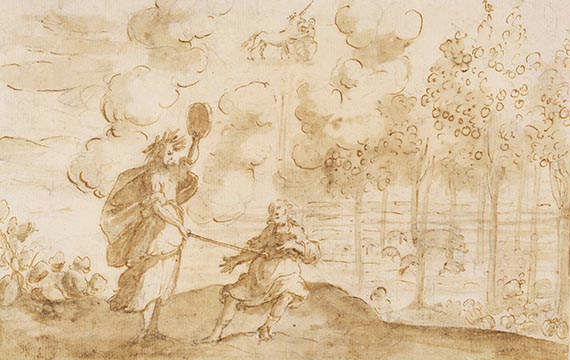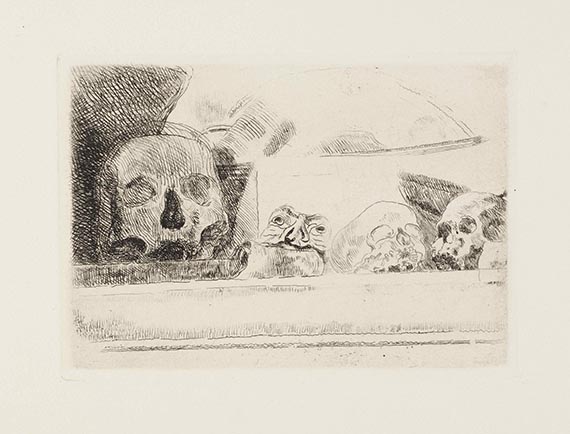
Stefano della Bella
1610 Florenz
1664 Florenz
The Italian illustrator, etcher, and painter Stefano della Bella was born on March 18, 1610 in Florence. In 1620, Bella joined the workshop of the goldsmith Giovanni Battista Fossi. A short time later, he switched to the studio of the engraver and medal-maker Gasparo Mola (1580 – 1640). The goldsmith Orazio Vanni had the artist first copy engravings by Jaques Callots (1592 – 1635) . Remigio Cantagallina (approx. 1582 – 1656), who was Callot’s teacher, helped Stefano della Bella in the beginning and sent him to Cesare Dandini (1592 – 1658). This is where the artist began training as a painter starting in 1625. He dedicated the earliest dated etching, the "Banquet of the Piacevoli" from 1627, to the brother of Grand Duke, Giancarlo de’Medici (1611 – 63). Beginning in September 1629, Bella was given the protection of Lorenzo de’Medici (1449 – 92). In 1630, he made a copy of Leonardo da Vinci‘s (1452 – 1519) "Trattato della Pitturan", which he illustrated with approx. 50 explanatory sketches.
In 1633 at the latest, Lorenzo de’Medici sent Stefano della Bella to Rome to learn painting with a monthly grant and lodging in the Palazzo Madama. During that same year, Bella etched the "Entry of the Polish Ambassador" on six plates that were lined up to form a frieze. This period of creativity in Rome resulted in numerous views of Rome, Tivoli, the Roman Campagna, ruins, and street scenes. Stefano della Bella loved portraying topics relevant to the current times. The sequence of six ocean views engraved in 1634 are evidence of the influence of Agostino Tassi (1580 – 1644). In June 1634, Bella interrupted his stay in Rome to visit Florence. In the subsequent years of 1637 – 39, he continually remained in Florence. His name appeared with the official job title of intagliatore among the artists employed at the court of the Medici in 1637. This year was also characterized by Bella’s close cooperation with Alfonso Parigi (1606 – 56). In 1638, he produced his first topographical description of a military campaign with the "Map of the Siege of Saint-Omer". In 1639, Bella joined the mission for sending congratulations to the French court on the birth of Louis XIV (1638 – 1715). He was commissioned by Richelieu (1585 – 1642) to etch the "View of the Sieged City of Arras" in 1641. The drawing of an allegory in honor of Richelieau, which is attributed to Bella, was created that same year. The publisher Francois Langlois commissioned the artist to draw copies based on Callot in 1642. In addition to Langlois, Israel Henriet (? - 1661), Callot’s Parisian publisher, was the most important buyer of Bella’s plates. Together with Israel Silvestre (1621 – 91), Henriet’s nephew, he etched a sequence of architectural views.
Beginning in 1645, the artist was enlisted by Anne d’Autrich (1601 – 66) for drawings of all performances at the "Théâtre du Petit Bourbon". He designed a title page and drew the animal ballets that performed as an interlude for the opera "La Finta Pazza". In 1649, Bella participated in the work "Les Triomphes de Louis le Juste XIII" by Jean Valdor (1616 – 70) in honor of Louis XIII (1601 – 43).
He returned to his hometown in 1650 and entered into the service of Matthias de’Medicis (1613 – 67). He instructed the young Cosimo III (1642 – 1723) in drawing. In addition, he was accepted into the Florentine literary circle of the Accademia degli Apasti. This marked the peak of his career.
In his last phase of creativity, Stefano della Bella produced the etched sequences "La Gara delle Stagioni, the Six Views of the Villa Pratolino" (1652), the "Views of the Harbor of Livorno" (1656), and "Six Views of Rome and the Roman Campagna". Three of Bella’s etchings illustrate the work of Moniglia’s "Il Mondo Festeggiante", which documented the festivities for the wedding between Cosimo III and Marguerite Louise d’Orléans (1645 – 1721) in 1661.
Stefano della Bella died in his native town of Florence on July 22, 1664.

Would you like to sell a work by Stefano della Bella?
Infos for sellerART MARKET:

Figurenszene
India ink drawing, 1650
Starting bid 720
More offers >






